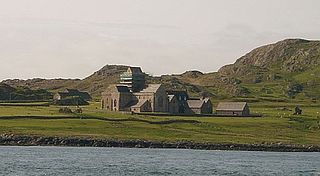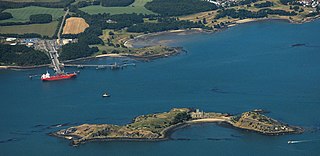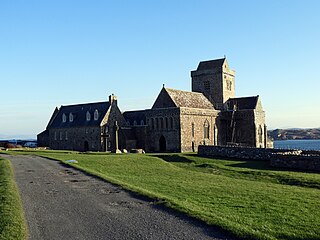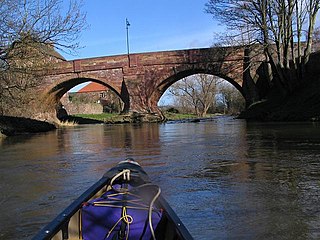Related Research Articles

Iona is a small island in the Inner Hebrides, off the Ross of Mull on the western coast of Scotland. It is mainly known for Iona Abbey, though there are other buildings on the island. Iona Abbey was a centre of Gaelic monasticism for three centuries and is today known for its relative tranquility and natural environment. It is a tourist destination and a place for spiritual retreats. Its modern Scottish Gaelic name means "Iona of (Saint) Columba".

East Lothian is one of the 32 council areas of Scotland, as well as a historic county, registration county and lieutenancy area. The county was called Haddingtonshire until 1921.

The River Tyne is a river in Scotland. It rises in the Moorfoot Hills in Midlothian near Tynehead to the south of Edinburgh, at the junction of the B6458 and the B6367. It continues approximately 30 miles northeast, and empties into the North Sea near Belhaven.

Inchcolm is an island in the Firth of Forth in Scotland. It was repeatedly attacked by English raiders during the Wars of Scottish Independence, and was fortified during both World Wars to defend nearby Edinburgh. Inchcolm now attracts visitors to its former Augustine Abbey.

Bathgate is a town in West Lothian, Scotland, 5 miles (8 km) west of Livingston and adjacent to the M8 motorway. Nearby towns are Armadale, Blackburn, Linlithgow, Livingston, West Calder and Whitburn. Situated 2 miles (3 km) south of the ancient Neolithic burial site at Cairnpapple Hill, Bathgate and the surrounding area show signs of habitation since about 3500 BC and the world's oldest known reptile fossil has been found in the town. By the 12th century, Bathgate was a small settlement, with a church at Kirkton and a castle south of the present day town centre. Local mines were established in the 17th century but the town remained small in size until the coming of the industrial revolution. By the Victorian era, Bathgate grew in prominence as an industrial and mining centre, principally associated with the coal and shale oil industries. By the early 20th century, much of the mining and heavy industry around the town had ceased and the town developed manufacturing industries, principally in vehicle production and later electronics before these factories closed in the late 20th century. Today Bathgate is the second largest town in West Lothian, after Livingston and serves as a regional commuter town within the Scottish Central Belt.

Sir Robert Rowand Anderson, was a Scottish Victorian architect. Anderson trained in the office of George Gilbert Scott in London before setting up his own practice in Edinburgh in 1860. During the 1860s his main work was small churches in the 'First Pointed' style that is characteristic of Scott's former assistants. By 1880 his practice was designing some of the most prestigious public and private buildings in Scotland.

The Royal Burgh of Haddington is a town in East Lothian, Scotland. It is the main administrative, cultural and geographical centre for East Lothian. It lies about 17 miles east of Edinburgh. The name Haddington is Anglo-Saxon, dating from the sixth or seventh century AD when the area was incorporated into the kingdom of Bernicia. The town, like the rest of the Lothian region, was ceded by King Edgar of England and became part of Scotland in the tenth century. Haddington received Burgh status, one of the earliest to do so, during the reign of David I (1124–1153), giving it trading rights which encouraged its growth into a market town.

Pencaitland is a village in East Lothian, Scotland, about 12 miles south-east of Edinburgh, 5 mi (8 km) south-west of Haddington, and 1 mi (2 km) east of Ormiston.

Iona Abbey is an abbey located on the island of Iona, just off the Isle of Mull on the West Coast of Scotland.
Christianity in Medieval Scotland includes all aspects of Christianity in the modern borders of Scotland in the Middle Ages. Christianity was probably introduced to what is now Lowland Scotland by Roman soldiers stationed in the north of the province of Britannia. After the collapse of Roman authority in the fifth century, Christianity is presumed to have survived among the British enclaves in the south of what is now Scotland, but retreated as the pagan Anglo-Saxons advanced. Scotland was largely converted by Irish missions associated with figures such as St Columba, from the fifth to the seventh centuries. These missions founded monastic institutions and collegiate churches that served large areas. Scholars have identified a distinctive form of Celtic Christianity, in which abbots were more significant than bishops, attitudes to clerical celibacy were more relaxed and there were significant differences in practice with Roman Christianity, particularly the form of tonsure and the method of calculating Easter, although most of these issues had been resolved by the mid-seventh century. After the reconversion of Scandinavian Scotland in the tenth century, Christianity under papal authority was the dominant religion of the kingdom.

Saddell Abbey is a ruined Cistercian monastery located in western Scotland. The abbey was established in 1160 by Somerled, Lord of Kintyre, who was killed in 1164. The abbey was completed by his son, Ragnall, a few years later. The original layout of the abbey included a church and three adjoining buildings grouped around a cloister. Saddell Abbey is widely known for its important collection of life-sized stone carvings and burial slabs that were constructed from the 14th to the 16th centuries. Historic Environment Scotland established the site as a scheduled monument in 1975.

The Collegiate Church of St Mary the Virgin is a Church of Scotland parish church in Haddington, East Lothian, Scotland.

In the early Middle Ages, there were distinct material cultures evident in the different federations and kingdoms within what is now Scotland. Pictish art was the only uniquely Scottish medieval style; it can be seen in the extensive survival of carved stones, particularly in the north and east of the country, which hold a variety of recurring images and patterns. It can also be seen in elaborate metal work that largely survives in buried hoards. Irish-Scots art from the kingdom of Dál Riata suggests that it was one of the places, as a crossroads between cultures, where the Insular style developed.

The Christianisation of Scotland was the process by which Christianity spread in what is now Scotland, which took place principally between the fifth and tenth centuries.

Sculpture in Scotland includes all visual arts operating in three dimensions in the borders of modern Scotland. Durable sculptural processes traditionally include carving and modelling, in stone, metal, clay, wood and other materials. In the modern era these were joined by assembly by welding, modelling, moulding and casting. Some installation art can also be considered to be sculpture. The earliest surviving sculptures from Scotland are standing stones and circles from around 3000 BCE. The oldest portable visual art are carved-stone petrospheres and the Westray Wife is the earliest representation of a human face found in Scotland. From the Bronze Age there are extensive examples of rock art, including cup and ring marks and elaborate carved stone battle-axes. By the early Iron Age Scotland had been penetrated by the wider European La Tène culture, and a few examples of decoration survive from Scotland. There are also decorated torcs, scabbards, armlets and war trumpets. The Romans began military expeditions into what is now Scotland from about 71 CE, leaving a direct sculptural legacy of distance slabs, altars and other sculptures.

East Linton Bridge, also called Old Tyne Bridge, is a bridge over the River Tyne in the village of East Linton in the county of East Lothian, Scotland. In 1971, the bridge was designated a category A listed building.

James Graham Fairley FRIBA MSGS (1846–1934) was a 19th/20th century Scottish architect working mainly in the West Lothian area, specialising in churches and schools.
Perpetua (Pip) Pope was a Scottish painter of landscapes, flower pieces and still-life compositions in both oil and watercolours, and was also an art teacher in Edinburgh.
References
- ↑ Mathers, Ewan (2004). The Cloisters of Iona Abbey. Wild Goose Publications. p. 176. ISBN 978-1-901557-60-2.
- ↑ Women in History of Scots Descent, http://www.electricscotland.com/history/women/wih25.htm